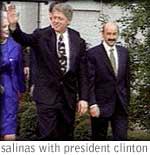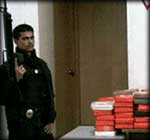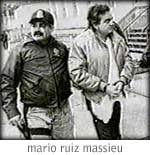



1988 Carlos Salinas de Gortari is elected president of Mexico. Many suspect the election was rigged and that perhaps Cuauhtemoc Cardenas of the PRD won.
January, 1992 Carlos Enrique Cervantes de Gortari (a cousin of Carlos Salinas) and Magdalena Ruiz Pelayo (who worked for Carlos's father) are convicted of drug trafficking charges in the U.S. and sentenced to 15 and 17 years respectively. This is the first established link between drug trafficking and the Salinas family.
1992 Carlos Salinas imposes the first written regulations on DEA officers in Mexico. The regulations limit the number of agents in Mexico, designate certain cities in which they must live, deny the officers diplomatic immunity, require all information to be turned over to Mexican authorities, and prohibit agents to carry weapons.
February 23, 1993 The date of a Mexico City private dinner that came to be known as the 'Billionaire's Banquet.' Carlos Salinas invites thirty of Mexico's richest businessmen and asks them to pledge $25 million each to the upcoming campaign and thus support Salinas's ambitions to build a political dynasty.
1993 The Mexican newspaper Processo later publishes documents that suggest Raul Salinas was present at a meeting that took place on this date at the Salinas ranch in Nueva Leon in which a payoff was made to Mexican drug officials by traffickers.
May 1993 Cardinal Juan Jesus Posadas is assassinated in Guadalajara. The assassination appears to be an accidental shooting during a gun fight involving the Arellano Felix Organization (the Tijuana drug cartel). But many people suspect it might have had a larger political motive.
 November 17, 1993 NAFTA is passed opening the Mexican market for the first time.
December 2, 1993 Mario Ruiz Massieu's top aide, Jorge Stergios, begins to transport cash-filled packages to a Houston bank account at the Texas Commerce Bank. The money is bundled with rubber bands and tied in plastic. Stergios continues to make twenty-four such deposits in the next thirteen months. The deposits are always cash, and range in quantity from $119,500 to $477,320. The bank is instructed not to invest the money, but to keep it in a checking account so it is liquid. The bank does not investigate the income source.
July 1993 Ricardo Salinas Pliego buys one of the state-owned government television stations with a $29 million dollar loan from Raul Salinas. Raul Salinas is later accused of helping Salinas Pliego win the bid.
January 1, 1994 A peasant rebellion in the Chiapas region gains international attention. The rebels, calling themselves the Emiliano Zapata National Liberation Army (EZLN), demand the end of government corruption and human rights violations, economic reform, democratization and improvement of living standards. The rebellion begins the same day NAFTA is to take effect.
March 23, 1994 Assassination of Luis Donaldo Colosio, PRI presidential candidate.
August 21, 1994 Ernesto Zedillo of the PRI party is elected President of Mexico, receiving about 50% of the vote.
September 28, 1994 Assassination of Jose Francisco Ruiz Massieu, who was about to become the PRI majority leader.
September 29, 1994 Manuel Munoz Rocha, a PRI congressman is last seen on this date, he has yet to reappear. He is later suspected in the Ruiz Massieu assassination. Many believe he is dead.
October 1994 Humberto Garcia Abrego, who allegedly handled the laundering for his brother Juan's Gulf cartel, is arrested.
November, 1994 The New York Times later says that on this date the U.S. government gave president-elect Zedillo a list of Mexican government officials they suspected of corruption or drug trafficking links--people the U.S. presumably did not want appointed to positions in the new government. Governors Manlio Fabio Beltrones and Jorge Carrillo Olea are both said to be on this list.
November 15, 1994 Mario Ruiz Massieu resigns from the investigation into his brother's murder saying that the PRI is blocking his investigation into the upper-level government officers who he suspects of involvement.
November 30, 1994 Carlos Salinas de Gortari hands the presidency over to Ernesto Zedillo.
December 20, 1994 Peso devaluation crisis. The Mexican peso plummets as investment money flows out of Mexico, and the wealthy convert their holdings into other currencies. The Mexican government seeks a foreign loan to avert total economic collapse.
January 30, 1995 President Clinton authorizes a $20 billion loan from the United States as part of a $50 billion international bailout loan to Mexico.
February 28, 1995 Raul Salinas is arrested for involvement in the Ruiz Massieu killing. Carlos Salinas begins a 36-hour hunger strike to protest allegations that surfaced with Raul's arrest that his administration might have been involved with the Colosio assassination, or blamed for the financial crisis.
March 2, 1995 Mexican authorities question Mario Ruiz Massieu for eight hours trying to determine if his investigation into his brother's murder covered up the involvement of Raul Salinas. Afterward, Ruiz Massieu flies to Houston.
March 3, 1995 Mario Ruiz Massieu is arrested in Newark, New Jersey for attempting to transport undeclared cash to Spain.
March 3, 1995 A secret meeting takes place between President Zedillo and Carlos Salinas. After this meeting, Carlos ends his hunger strike and any allegations that his administration had been involved with both the Colosio death and the financial crisis are dropped.
March 1995 The United States seizes $ 9 million in a Houston bank account belonging to Mario Ruiz Massieu. U.S. authorities suspect the money is linked to drugs, corruption, or his brother's murder; many suspect Ruiz Massieu was paid to keep Raul Salinas's name out of his investigation.
March 10, 1995 Carlos Salinas leaves Mexico for an unknown destination.
March 1995 Mexico State Police agents attempt to mug President Zedillo's son without realizing who it is. They are stopped by the boy's bodyguards.
 June 1995 Mexican officials capture a cartel drug baron and thirty-two judicial police agents who helped protect him and his drug trafficking business. The drug cartel baron had reportedly been paying $40 million a month to top Federal Judicial Police officers
November 1995 A large cargo plane used to transport drugs from Mexico to the U.S. is found in Baja, California. The airplane reportedly transported 17 tons of cocaine originally from Colombia. The plane was loaded and off-loaded with the assistance of Mexican State and Federal Police. The investigation results in 20 arrest warrants against Mexican Police officials.
November 15, 1995 Paulina Castanon, wife of Raul Salinas, is arrested in Switzerland for trying to access Raul's safe deposit box at a private bank. She is questioned by Swiss investigators who tell her the reason for her arrest was a Swiss suspicion that some of the $100 million or more in Raul's foreign accounts was connected to drug trafficking.
January 14, 1996 Juan Garcia Abrego, head of the Gulf Cartel, is arrested by Mexican authorities. Because he is a U.S. citizen, he is later sent to the U.S. for trial.
March 1996 DEA agents arrest two Mexican police officers in Sonora, Mexico with 1100 pounds of marijuana. The police officers later admit that they work at a marijuana stash house.
July, 1996 Mexican army officials arrest nine Mexican Federal police officers with 50 kilograms of cocaine and $578,000.
October 9, 1996 Federal prosecutor, Pablo Chapa Bezanilla unearths a body on a ranch belonging to Raul Salinas. Attorney general, Lozano had predicted that the body was that of Manuel Munoz Rocha. The prosecutors were led to the body by Francisca Zetina Chavez, a psychic. The body turned out not to be Rocha, but a relative of Zetina's. Zetina, Chapa, and Lozano fall under suspicion of trying to frame Raul Salinas.
October 16, 1996 Juan Garcia Abrego is convicted of cocaine smuggling by a U.S. court, and later sentenced to 11 life terms.
November 1996 Prosecutors question Carlos Salinas about the Colosio assassination.
November 1996 Mexico's government passes an Organized Crime Law which gives law enforcement officials more power, specifically, authorization to conduct electronic surveillance and use informants, provisions for a witness protection plan, and additional laws against conspiracy.
December 2, 1996 Pablo Chapa Bezanilla, Mexico City's top prosecutor is fired because of his handling of the Raul Salinas case.
December 1996 Antonio Lozano Gracia is dismissed as Attorney General. Jorge Madrazo Cuellar is appointed as the new Attorney General by president Zedillo.
January, 1997 Francisca Zetina Chavez and several associates are arrested for body snatching and manufacturing evidence, among other charges. Zetina says she did it to collect the reward Chapa was offering for evidence against Raul Salinas.
January, 1997 Gen. Jesus Gutierrez Rebollo leads troops in an attack on a ranch where they believe Amado Carrillo Fuentes is attending his sister's wedding. The wedding is guarded by Mexican Federal police, and Carrillo is not there.
January 27, 1997 Mexican prosecutors question Carlos Salinas for sixteen hours in Dublin about the Ruiz Massieu killing.
February 18, 1997 Gen. Jesus Gutierrez Rebollo is arrested for working with drug traffickers, especially Amado Carrillo Fuentes, for the past seven years while he was head of Mexico's version of the DEA.
February 23, 1997 President Zedillo announces new measures that will be taken to combat drug trafficking.
February 23, 1997 The New York Times publishes a story accusing Jorge Carrillo Olea, Governor of Morelos and Manlio Fabio Beltrones, Governor of Sonora of being allied with drug traffickers, especially Amado Carrillo Fuentes, since 1992. Both governors deny the charges. The Times cites accounts by American officials that Raul Salinas received suitcases full of cash from drug traffickers to distribute to Mexican government officials at a meeting that took place in 1993. The Times based the article on accounts by American officials, classified documents, and theTimes' own four-month investigation.
February 16 1997 Proceso publishes documents leaked from the Houston civil trial that suggest Raul Salinas, his father Raul Salinas Lozano, and his brother-in-law Francisco Ruiz Massieu maybe linked to drug trafficking activities. If this proves true, father and son would face criminal trials in the United States.
February 27, 1997 Mexican officials capture Oscar Malherbe de Leon, supposed heir to Juan Garcia Abrego, the former head of the Gulf cartel. de Leon allegedly offered officials $2 million in a bribe for his release, but was denied.
February 28, 1997 President Clinton signs a certification that Mexico is cooperating in the drug war. There is congressional opposition. Congress is expected to debate certification, and, possibly reverse it.
February 28, 1997 Humberto Garcia Abrego, a suspected drug money launderer, inexplicably walks out of a Mexican jail (where he was reportedly staying in a six room suite with telephones and cable t.v.) hours after Clinton's certification.
Week of March 3, 1997 Mexican newspapers report that investigations have begun into allegations that Adriana Salinas Yanez had links to former Colombian drug cartel kingpin Pablo Escobar Gaviria. Adriana Salinas has denied these charges.
Week of March 3, 1997 Mexico's re-certification is hotly debated in the United States.
March 4, 1997 Pablo Chapa Bezanilla is accused of conspiring with Zetina in body snatching and manufacturing evidence, and for misuse of public funds. Chapa flees and is in hiding in Mexico.
March 6, 1997 President Zedillo makes a speech in response to a House committee vote to override President Clinton's certification. In the speech Zedillo says that many of the measures the U.S. wants Mexico to pursue in its war on drugs violate Mexican sovereignty.
March 7, 1997 President Clinton sends General Barry McCaffrey, head of the U.S. anti-drug effort, to Mexico for a meeting with President Zedillo.
March 10, 1997 First day of a civil trial in Houston, Texas in which the United States is trying to seize $9 million dollars from an account belonging to former Deputy Attorney General of Mexico, Mario Ruiz Massieu. The government suspects that Ruiz Massieu was paid this money while in office by drug traffickers in exchange for protection.
March 10, 1997 Juan Antonio Ortiz, a Gulf cartel member testifies he coordinated the movement of more than 10 tons of Gulf cartel cocaine worth $200 million at wholesale, across the Mexico-United States border in the past few years.
March 10, 1997 President Zedillo names Mariano Herran Salvatti the new head of Mexico's equivalent of the DEA. Salvatti replaces Gen. Jose Jesus Gutierrez Rebollo who is accused of corruption and links to drug traffickers.
 March 10, 1997 Zedillo announces new regulations to limit money laundering that requires banks and brokerage houses to report suspicious transactions.
March 12, 1997 Raul Macias a former bodyguard for a corrupt Mexican federal police commander, testifies in Houston that he put two suitcases filled with cash into Mario Ruiz Massieu's parked car, while Ruiz Massieu sat in the passenger seat. The money was part of a payoff from a cocaine delivery.
March 15, 1997 A Houston jury finds Mario Ruiz Massieu guilty of taking bribes from narcotics traffickers. The jury returns $ 1.1 million to Ruiz Massieu which had been given to him by his father. The remaining $7.9 million in the suspect account is seized by the U.S. government.
March 13, 1997 The U.S. House of Representatives approves a bill that would impose sanctions on Mexico in 90 days unless Mexico takes "concrete measures" to combat corruption and cooperate with U.S. anti-drug efforts.
March 16, 1997 The PRI loses over half of its seats, and the PRD makes large gains in a state election in Morelos. Many people believe this election is a sign of what will happen in the national election in July.
March 17, 1997 A Mexican army brigadier general is arrested on bribery charges. The officer is accused of being employed by the AFO (Tijuana Cartel), and attempting to bribe the authorities in Baja $1 million a month for allowing drug trafficking through the state into the United States. The official also threatened the top federal justice official in the area with murder (of himself and his family) if he did not comply. The man's predecessor had been assassinated in September 1996.
March 20, 1997 The U.S. Senate votes to support President Clinton's certification of Mexico, but requires the President to make a report to Congress on September 1, 1997 about the progress Mexico has made in drug enforcement. This bill will replace the House measure passed on March 13.
Week of May 6, 1997 President Clinton has scheduled his first state visit to Mexico.
July 1997 First Mexican election in 70 years in which the PRI's dominance will be contested. The first election for the mayor of Mexico City will also take place. Many predict the PRI will lose the mayoral election and control of the lower house of the national government.
October 1, 1997 A new initiative passed by president Clinton takes effect, providing for a $367 million Justice Department budget for the Southwest border. The money will help support the initiative's call for the 500 new border patrol agents, 277 new immigration inspectors, 96 new DEA agents, and 70 new FBI agents .
January 21, 1999 Following a trial that lasted four years,
Raul Salinas was convicted of ordering the murder of Jose Francisco Ruiz Massieu
and received a 50 year prison sentence. However, six months later,on July 16, 1999,
an appeals court reduces the sentence to 27 1/2 years, ruling that the prosecution had failed
to show a motive for Salinas to have committed the killing.
September 13, 1999 Mario Ruiz Massieu, the brother of the
assassinated Jose Francisco Ruiz Massieu, commits suicide in New Jersey. He was facing
money laundering charges in the U.S. In his suicide note, he blames former President Zedillo
for his own death and that of his brother.

home · interviews ·
family tree ·
readings ·
maps ·
chronology ·
mexican news ·
links ·
discussion
tapes & transcripts ·
press
FRONTLINE ·
wgbh ·
pbs online
web site copyright WGBH educational foundation
 |